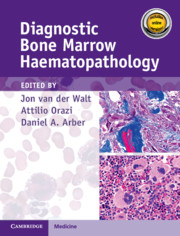Book contents
- Diagnostic Bone Marrow Haematopathology
- Diagnostic Bone Marrow Haematopathology
- Copyright page
- Contents
- Contributors
- Preface
- Acknowledgements
- Chapter 1 The Bone Marrow Biopsy
- Chapter 2 The Normal Bone Marrow
- Chapter 3 Necrosis, Stromal Changes and Artefacts
- Chapter 4 Aplasia
- Chapter 5 Hyperplasia
- Chapter 6 Infective, Granulomatous and Benign Histiocytic Disorders
- Chapter 7 Malignant Disorders of the Histiocytic/Dendritic Lineage
- Chapter 8 Myelodysplastic Syndromes
- Chapter 9 Acute Myeloid Leukaemia
- Chapter 10 Myeloproliferative Neoplasms
- Chapter 11 Myelodysplastic/Myeloproliferative Neoplasms
- Chapter 12 Systemic Mastocytosis
- Chapter 13 Myeloid and Lymphoid Neoplasms Associated with Eosinophilia
- Chapter 14 Precursor Lymphoid Neoplasms
- Chapter 15 Mature Lymphoid Neoplasms
- Chapter 16 Plasma Cell Neoplasia
- Chapter 17 Metastatic Lesions
- Chapter 18 Bone Marrow Changes Following Therapy and Immunosuppression
- Chapter 19 Immunohistochemistry and Flow Cytometry in Bone Marrow Haematopathology
- Chapter 20 Molecular Diagnostics in Bone Marrow Haematopathology
- Index
- References
Chapter 11 - Myelodysplastic/Myeloproliferative Neoplasms
Published online by Cambridge University Press: 12 November 2020
- Diagnostic Bone Marrow Haematopathology
- Diagnostic Bone Marrow Haematopathology
- Copyright page
- Contents
- Contributors
- Preface
- Acknowledgements
- Chapter 1 The Bone Marrow Biopsy
- Chapter 2 The Normal Bone Marrow
- Chapter 3 Necrosis, Stromal Changes and Artefacts
- Chapter 4 Aplasia
- Chapter 5 Hyperplasia
- Chapter 6 Infective, Granulomatous and Benign Histiocytic Disorders
- Chapter 7 Malignant Disorders of the Histiocytic/Dendritic Lineage
- Chapter 8 Myelodysplastic Syndromes
- Chapter 9 Acute Myeloid Leukaemia
- Chapter 10 Myeloproliferative Neoplasms
- Chapter 11 Myelodysplastic/Myeloproliferative Neoplasms
- Chapter 12 Systemic Mastocytosis
- Chapter 13 Myeloid and Lymphoid Neoplasms Associated with Eosinophilia
- Chapter 14 Precursor Lymphoid Neoplasms
- Chapter 15 Mature Lymphoid Neoplasms
- Chapter 16 Plasma Cell Neoplasia
- Chapter 17 Metastatic Lesions
- Chapter 18 Bone Marrow Changes Following Therapy and Immunosuppression
- Chapter 19 Immunohistochemistry and Flow Cytometry in Bone Marrow Haematopathology
- Chapter 20 Molecular Diagnostics in Bone Marrow Haematopathology
- Index
- References
Summary
The myelodysplastic/myeloproliferative neoplasms (MDS/MPN) are clonal myeloid neoplasms characterized at the time of their initial presentation by the simultaneous presence of myelodysplastic and myeloproliferative features, which prevent them from being classified as either myelodysplastic syndrome (MDS) or myeloproliferative neoplasm (MPN). The incidence of MDS/MPN is estimated at 0.1 to 3/100,000 individuals. They are characterized by hypercellular bone marrow (BM) morphology due to proliferation in one or more of the myeloid lineages. Cytopaenias and dysplastic changes of any cell line may be seen in conjunction with elevated white blood cell (WBC) counts, thrombocytosis and organomegaly, features more commonly associated with MPN. Hepatosplenomegaly is frequently seen. The most common entities within the MDS/MPN group include chronic myelomonocytic leukaemia (CMML), atypical chronic myeloid leukaemia BCR-ABL1 negative (aCML) and juvenile myelomonocytic leukaemia (JMML), which is seen exclusively in paediatric patients. A less well-defined group of MDS/MPN-like diseases includes MDS/MPN unclassifiable (MDS/MPN-U) and a recently recognized entity of MDS/MPN with ring sideroblasts and thrombocytosis (MDS/MPN-RS-T), previously known as refractory anaemia with ring sideroblasts and thrombocytosis (RARS-T). It was considered a provisional entity within the group of MDS/MPN-U in the 2008 edition of the WHO, but has now been promoted to a true entry in the updated 2016 WHO edition. Since the publication of the last WHO Classification in 2008, multiple studies have examined the molecular pathogenetic features of the MDS/MPN entities (see Table 11.1). Many of these results have been incorporated into the updated 2016 WHO classification.
Keywords
- Type
- Chapter
- Information
- Diagnostic Bone Marrow Haematopathology , pp. 162 - 180Publisher: Cambridge University PressPrint publication year: 2021

